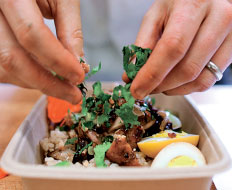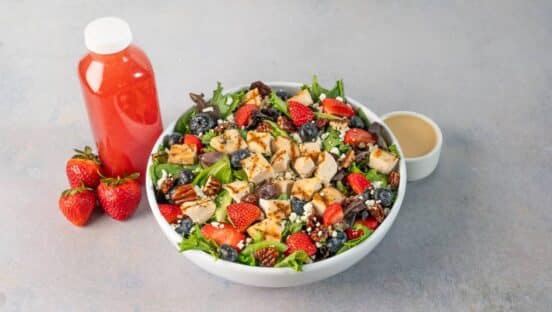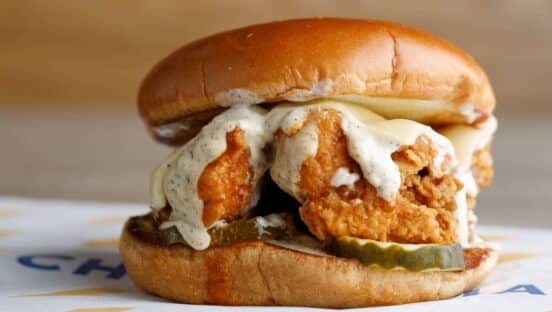I made my own pizza for lunch the other day, and I have to say it was pretty great. Now, in the interest of full disclosure, I admit I’m taking a little license with the language by saying I “made” this pizza. I didn’t roll out or toss the dough, though I did choose my crust from a few available varieties, as was my prerogative. I also didn’t slave over a saucepan to get the tomato sauce a little smoky, a little spicy, and distinctly tangy, the way I like it.
In terms of cheese, I had several options, ranging from smoked Mozzarella to goat cheese, Brie, and truffle Pecorino, but I didn’t have to grate or smear the stuff over the crust before tossing the whole works in the oven—which, come to think of it, I really didn’t do, either. Also, while I treated myself to a wealth of toppings, including fresh oregano and basil, some crushed red peppers, oven-roasted red onions, and bell peppers, I didn’t visit the farmers’ market or the grocery store produce section beforehand (or at all, really).
The truth is, I didn’t contribute a single thing to the physical process of crafting that pizza. I didn’t even drizzle olive oil on top before digging into it with a level of eagerness you’d expect from a bullmastiff on a beef bender. And yet, as far as I’m concerned, I made that pie. Or created it, at the very least, since the good people behind the counter and 2-foot-high sneeze guard at the Bay Area establishment where I was dining assembled this beauty at my behest. Of course, they’ll do the same for anyone with the ability to pay, point, and oversee the from-scratch construction of a particularly personal personal-sized pizza.
I recount this special lunchtime adventure because it neatly illustrates what people—particularly members of the Millennial generation, who consider food customization something of a birthright—adore about build-to-order concepts, whether they’re one-off outlets like the one I’ve described or massive chains, like Chipotle. A few qualities they specifically enjoy:
Freshness. Vegetables, proteins, herbs, spices, and condiments that are prepared in-house telegraph quality and care. It’s clear that an actual human being took time and effort to make this spread of delicious-looking items ready for inspection and selection, and consumers are responding with enthusiasm to what they see.
Transparency. There’s something highly satisfying about watching your meal get made to order right in front of your face by an attendant, rather than having it put together by a back-of-house employee whose gloved hand is all you see. Interacting with a friendly, knowledgeable foodservice employee can also help you make better choices and improve the social aspect of the restaurant experience.
Flavor-forward presentation. At my Bay Area pizza spot, I was struck by the sight of branches of whole, dried oregano that were crushed and sprinkled by hand over my pie before it was handed across the counter. The visual cue of the real, whole herb being hand-selected and turned into a condiment signaled that intense flavor was afoot even before I’d taken the first bite.
Diet friendly. When a menu item is being assembled to order, I’m free to choose a gluten-free crust, a low-carb tortilla, and fat-free or non-dairy cheese. I can also ask the counter help to go easy on the olive oil, salad dressing, and mayo—and provide very specific directions on what “easy” means. The ability to regulate one’s own portion size and ingredient mix is a powerful tool for dieters and the health-conscious.
Fast-casual concepts have made freshness and customization one of their hallmarks, and in the process, they’ve significantly upped the ante when it comes to quality, earning the repeat business of legions of former quick-serve regulars in the process. But incremental customization could also work for fast food.
The thing about raising people’s expectations is that there’s no getting that genie back in the bottle. So what can fast-food outlets—whose physical plants were never built to suit the build-to-order operational model—do to catch the wave? Mainstream fast-food chains won’t likely upend their business models or reconfigure 10,000 restaurant kitchens to get in on the build-to-order trend. But it may yet be possible for them to adopt certain symbolically important and operationally feasible elements of the build-your-own concepts to meet guests’ growing preference for customization.
For instance, what if one preparation station at a fast-food hamburger chain were reconfigured so that you could see your sandwich being finished by the employee behind the counter? The mere sight of an individual being involved in the construction of your meal would signal a greater level of care and finesse than having the item wrapped in paper or foil and passed through to the holding bins.
In a similar vein, chains might also consider adding a condiment area where employees would prepare a customized cup or tray of sauces, spreads, dashes, and dollops for customers to take to their tables or carry off in their takeaway bags. Even something as simple as the ability to build your own condiment array would be a step in the right direction.
What’s become eminently clear as more fast-casual concepts embracing the build-to-order ethos have emerged is that once people have experienced the power of choice, they like it. But for concepts that can’t rework their entire approach to adopt the customized model, there are still smaller but significant ways to apply some build-to-order basics in a traditional setting.











